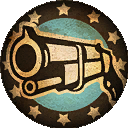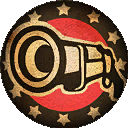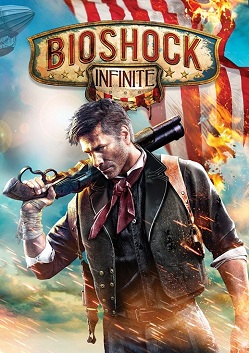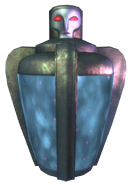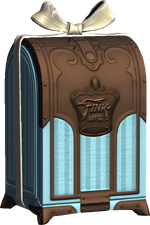Another post about Bioshock Infinite. This time I think I glimpsed something that became cut content, or maybe unreleased content: it's hard to tell when I'm just guessing from promotional material and the final game. Either way, we'll file this under DLC speculation for now. Bioshock players beware: plot speculation may include spoilers ahead. You've been cautioned. Is the bold too much? It feels like it's too much.
Early in Bioshock Infinite's dev cycle, enemies were more patriotic, wearing red-white-and-blue ensembles. Saltonstall, a politician from one of the early trailers, wore striped pants in this fashion. A Handyman in a demo wears a similar outfit. However, in later versions enemies are almost totally stripped of this political chic. The outfits are streamlined, divided into either blue outfits or red. Blue is the color of the Founders; most soldiers wear blue, their outfits assembled to look like uniforms or military gear. Their gun icons are blue. The Vox always wore red, but it's further codified as numerous enemies were given red character models, and the Vox weapons are adorned with red ribbons, in addition to their red gun icons.
At one point in the game, you emerge to find the Vox are your allies. Friendly without being Possessed, they join you in the fight against the Founders. If you attack one (as I did, not realizing that the guys executing unarmed men were supposed to be on my side) the game warns you to stop shooting allies. This mechanic is explored for the next five minutes, then never discussed again. It was heavily touted in press releases that in certain instances enemies wouldn't attack unless provoked, which seems like a mechanic that would play into factional combat.
Knowing all that going into BSI, I assumed that the faction-specific guns were relevant to that. Most of the guns are nearly carbon copies across the aisle. The mechanics are slightly modified between factions, but in practice most weapons are nearly identical. Additionally, upgrades are faction-specific; upgrading the Vox Heater doesn't improve the Founder China Broom or vice versa, so if you want a fully upgraded shotgun you're loosely encouraged to pick sides. There's the rub! The game's enemies were redesigned, seemingly to help players differentiate between the Founders and the Vox. The combat system was designed to facilitate the player swapping between weapons, but then you're heavily encouraged to invest in faction specific weaponry. The game even offers warnings when you hit allies in the one section where that is legitimately a serious concern. Factional combat was baked into BSI, and then almost totally ignored.
So I was thinking about how it could have been expressed. It's pretty simple: as you enter an area, enemies might take exception to the gun you were carrying and attack you, declaring you an enemy sympathizer. Alternatively, killing enemies could make the other side sympathetic to you. Depending on your relationship with a faction, they might offer you side-quests. Potential hostiles would ally with you and you could turn battles in their favor. Allies, for ease of recognition, would share faction-specific HUD colors in addition to their appearance. How strongly do you sympathize with a particular faction? Will you fight to further their goals, or will you use them to further your own?
Why do I care about this? Well, Bioshock Infinite doesn't have a mechanic that carries it in an interesting direction the way that Bioshock's Little Sisters do. I also feel that a factional system makes for the possibility of a more interesting "moral system": rather than saying "Press X to be Good or press Y to be Evil", the game would let you join a party, then decide whether or not you want to toe the party line. Which faction you join and how much effort you put into serving them influences the outcome of the story.
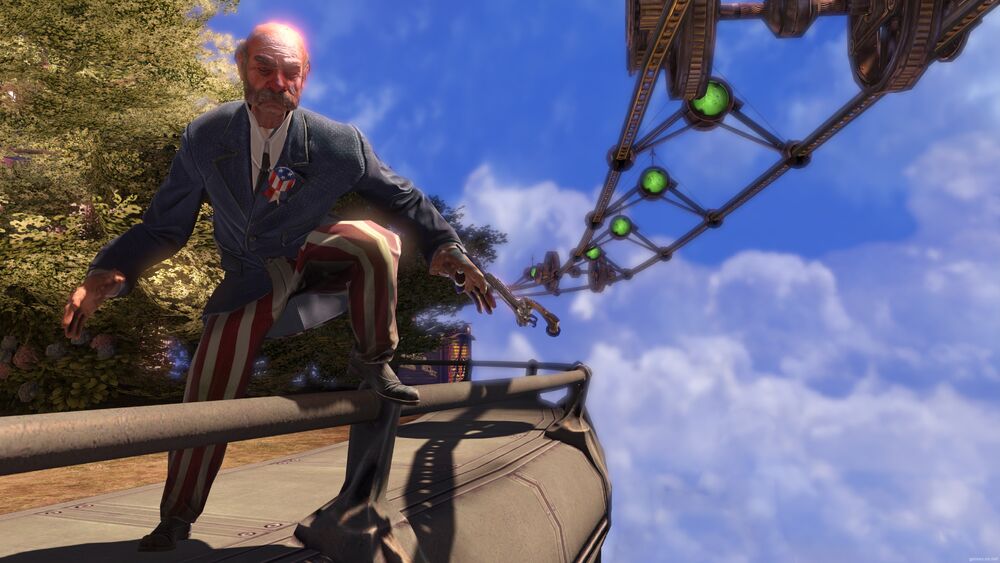 |
At one point in the game, you emerge to find the Vox are your allies. Friendly without being Possessed, they join you in the fight against the Founders. If you attack one (as I did, not realizing that the guys executing unarmed men were supposed to be on my side) the game warns you to stop shooting allies. This mechanic is explored for the next five minutes, then never discussed again. It was heavily touted in press releases that in certain instances enemies wouldn't attack unless provoked, which seems like a mechanic that would play into factional combat.
Knowing all that going into BSI, I assumed that the faction-specific guns were relevant to that. Most of the guns are nearly carbon copies across the aisle. The mechanics are slightly modified between factions, but in practice most weapons are nearly identical. Additionally, upgrades are faction-specific; upgrading the Vox Heater doesn't improve the Founder China Broom or vice versa, so if you want a fully upgraded shotgun you're loosely encouraged to pick sides. There's the rub! The game's enemies were redesigned, seemingly to help players differentiate between the Founders and the Vox. The combat system was designed to facilitate the player swapping between weapons, but then you're heavily encouraged to invest in faction specific weaponry. The game even offers warnings when you hit allies in the one section where that is legitimately a serious concern. Factional combat was baked into BSI, and then almost totally ignored.
So I was thinking about how it could have been expressed. It's pretty simple: as you enter an area, enemies might take exception to the gun you were carrying and attack you, declaring you an enemy sympathizer. Alternatively, killing enemies could make the other side sympathetic to you. Depending on your relationship with a faction, they might offer you side-quests. Potential hostiles would ally with you and you could turn battles in their favor. Allies, for ease of recognition, would share faction-specific HUD colors in addition to their appearance. How strongly do you sympathize with a particular faction? Will you fight to further their goals, or will you use them to further your own?
Why do I care about this? Well, Bioshock Infinite doesn't have a mechanic that carries it in an interesting direction the way that Bioshock's Little Sisters do. I also feel that a factional system makes for the possibility of a more interesting "moral system": rather than saying "Press X to be Good or press Y to be Evil", the game would let you join a party, then decide whether or not you want to toe the party line. Which faction you join and how much effort you put into serving them influences the outcome of the story.

